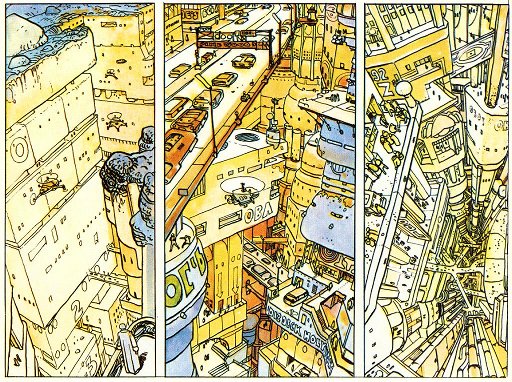June 8, 2010
The Long Tomorrow
Review By: Mr. Roboto
Authors: Dan O’Bannon & Jean “Moebius” Giraud (Illustrator)
Year: First appeared in Metal Hurlant, 1976
Category: Cyberpunk Books; Graphic Novels; Proto-Cyberpunk Media
Another piece of the proto-cyberpunk puzzle is found. So far, proto-cyberpunk media has dealt more with the themes of cyberpunk. But what about the look, that Blade Runner-esque future with stratosphere busting skyscrapers and flying cars? Did Ridley Scott have that vision in his head all along?
NOPE.
As it turns out, there was a major influence that would spark the future visions of Scott and Gibson: A short comic about a private eye (or “nose” as the main character called himself) who is hired to retrieve a package. The story itself isn’t much (too short to call it a novel), but the artwork is what influenced Scott and Gibson.
(From Blade Runner Movie site) “Years later, I was having lunch with Ridley, and when the conversation turned to inspiration, we were both very clear about our debt to the Metal Hurlant [the original Heavy Metal magazine] school of the ’70s–Moebius and the others. “

Problem: Metropolis had these city scenes some fifty years earlier! Did Gibson and Scott ever see Metropolis? Apparently not, since they give their props to Moebius:
“So it’s entirely fair to say, and I’ve said it before, that the way Neuromancer-the-novel “looks” was influenced in large part by some of the artwork I saw in ‘Heavy Metal’. I assume that this must also be true of John Carpenter’s ‘Escape from New York’, Ridley Scott’s ‘Blade Runner’”, and all other artefacts of the style sometimes dubbed ‘cyberpunk’. Those French guys, they got their end in early.”
Fritz Lang and the Germans beg to differ.
My advice: Check both out and see who had the future first.





Comments
June 8, 2010
Klaw said:
While the shots you show here do suggest a Metropolis look, in the short story these “skyscrapers” are actually underground. You’re looking down into a canyon, more akin to a Death Star trench on a moon rather than a Lang Utopia. Secondly, the beef of the story isn’t the city but the grunge… the backalley beat cop noir vibe seen in BR is all over this story. Noir wasn’t around at the time of Lang, and wasn’t really adapted to film or media until Alphaville.
For the full comic, go here: http://kipplezone.tripod.com/id1.html (bottom of the page)
June 14, 2010
Haeckel said:
I agree with the first commenter. It’s the gritty, rainy, visually crowded future, full of neon signs and a haphazard mix of architectural and clothing styles, that was really groundbreaking about Blade Runner, and that make it still look contemporary. Compared to the clean, streamlined, minimalist settings where everyone is wearing some kind of jumpsuit which prevailed from the thirties (Things To Come) through the seventies (Logan’s Run) in futuristic scenarios, Blade Runner represents an astonishing aesthetic leap. (Even Alphaville’s settings mostly look clean and minimalist, although the trench coat did set it apart.)
The most dated aspects of Blade Runner are the Metropolis/Jetsons/Metal Hurlant-type elements - flying cars, mountain-sized skyscrapers, space colonies. Cyberpunk films soon largely discarded these stereotypical sci fi tropes.
June 30, 2010
Clarice at Postal Gold said:
Apparently they missed Metropolis at the cinema, although the graphics and illustrations really are something else.
July 5, 2010
SSJKamui said:
Actually, some sources in the web claim that the look of Blade Runner was actually influenced by both, Métal Hurlant and Metropolis. (I think in Wikipedia, there is this claim, too)
Personally, I also think the british 200AD Magazine which had a premise which was very similar to Métal Hurlant, was also a big influence on Cyberpunk style.
SSJKamui said:
The production designs of the movie “The Fifth Element” were also developed by the artists Jean Giraud and Jean-Claude Mézières who worked for Métal Hurlant.
August 23, 2010
André said:
Hi,
By chance I stumbled upon this post and were very impressed with the artwork. Being a huge fan of the the graphics of Akira and Ghost in the Shell, I’d like to get my hands on a printed copy of the Long Tomorrow.
Do the work exist in an entire volume, and if, do you know where I could get my hand on a copy of it.
Also, If you (off the top of your head) got a tip of a film or such in the likes of Akira I should check out, please let me know!
Thanks.
September 6, 2010
Nathan said:
It’s also possible that Scott and Gibson were simply exposed to Moebius first, making his work more influential than Metropolis.
Bat said:
Im hearing that Peter Jackson bought the rights the Metropolis, Fran Walsh to write the screenplay, Jackson to produce and direct